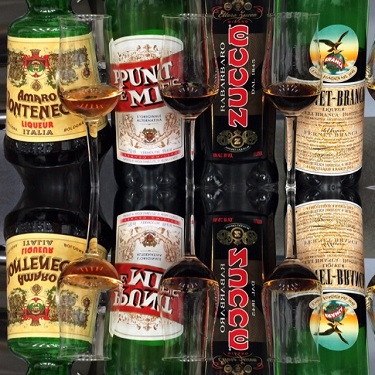
Back in our Orlando days, we made a discovery which has shaped our palates and capped our evenings since—amaro. Amari (plural for “amaro”) are a class of Italian digestives derived from soaking bittering agents in alcohol. The word “amaro” actually means “bitter” in Italian. These spirits find their origins in the shops of alchemists or in the pantries of monasteries where they were used as cure-alls and tonics. Long day at work? Amaro. Hangover? Amaro. Broken heart? Amaro. Yankees lose a series? You get the idea. So, because you are so special, we will give you a tour of the bitter shelf, let you in on a little house secret, and wrap it up with a science lesson.
For the record, most European countries have some sort of bitter domestic spirit in which they specialize, and we do carry a few of those as well, but for now we will focus on the Italians. Amari are commonly drunk straight after a meal or sometimes mixed with soda or tonic water to be used as an aperitif. We also use several as cocktail ingredients.
Amaro Montenegro: The lightest and sweetest of the group. This one originates with a guy in Bologna attempting to recreate a spirit he enjoyed while traveling in Montenegro. It is made from more than 40 herbs and was first introduced in 1885. 46 Proof. $4 Single / $7 Double. Amber colored. Warm, toasty, caramel-sugar, nose reminiscent of Dunkin’ Doughnuts. Nougat, sage, peppercorns, mouth-coating sweetness, grassy, tannic, eucalyptus, menthol. Long spice-laden finish.
Punt e Mes: A disclaimer, since Punt e Mes is made with a wine base, it is technically a vermouth. But because of its luscious bitter characteristics, we prefer to use it as an amaro, and hence it has made this list. Many of the vermouths we offer are lovely and bitter, but not like this treat. (We will get into vermouths soon…) Translating to “point and a half” the name “Punt e Mes” may refer to a ratio of one part sweet to half-part bitter. It resides on the bitterness scale somewhere between sweet vermouth and say, Fernet (more later). 32 Proof. $4 Single / $6 Double. Light in color, light roast coffee. Smells of wine cellar, barrel room, dank, garden mint, salt taffy. Cherry cola, upfront spice, nutty, sherry-ish flavors. Long tannic finish showing very bitter quinine, green stems, sappy, fresh-cut wood.
Zucca Rabarbaro: Originated in Milan in 1845, it was created by a fella named Ettore Zucca. The word “Rabarbaro” refers to rhubarb whose roots lend Zucca much of its bitterness. Other Chinese-style medicinals are added to round out the flavor. 32 Proof. $4 Single / $7 Double. Green vegetables, char, bitter chocolate, coffee beans, leaf pile, and tilled soil take the nose. The sweetness is a surprise (think condensed milk and demerara) and is balanced by ashcan, with sharp and biting and aggressive bitterness. Extra sugar black coffee, vegetal notes, grilled artichoke, flowers, and sea salt round out the finish.
Fernet Branca: Fernet is actually a subset of the amaro category while Branca is the producer. Fernet Branca enjoys a fairly hearty following both here at Hand + Foot, and with chefs and hospitality folks stateside. Here’s our house secret…Fernet is the shift shot of choice at Hand + Foot where we order six bottles bi-weekly and where we sell maybe two shots a month. Perhaps it is superstition? Or maybe we just do need a cure-all to close the night? Either way it’s how we do. 78 Proof. $6 Single / $9 Double. Alcohol, mint menthol, Tom’s toothpaste nose. Thai basil, biting spice, and goldenseal make appearances on the palate. The driest finish of the group, warming, rewarding, with mint and just a hint of chili spice, and a wonderful slightly numbing alcohol presence.
Here’s your science lesson for the day. Bitter is bitter for a reason, generally a warning to the would-be ingestor that what you are about to eat or drink is possibly toxic. Babies, for instance, seem to innately dislike bitter things (making for plenty of rewarding kid’s-first-lemon YouTube videos). But, as we grow into adults, our brains and bodies learn to actually enjoy bitter things. Can you imagine actually requesting Brussels sprouts as a kid? As grown-ups, because of the pleasing metabolic and pharmacological results of bitters’ consumption, we start to see the value in bitter and begin to seek it out. Now, imagine adding alcohol to the mix and you might see how easy it is to acquire a taste for these pleasing spirits. Maybe you should run some experiments at Hand + Foot to see for yourself.
–Now[ish]
Source: Old H+F Blog


